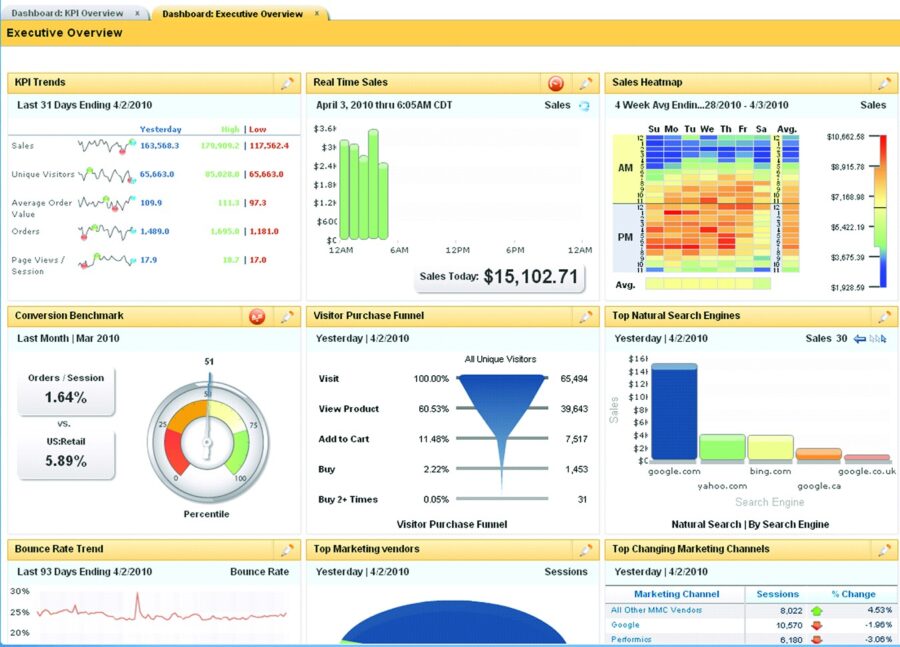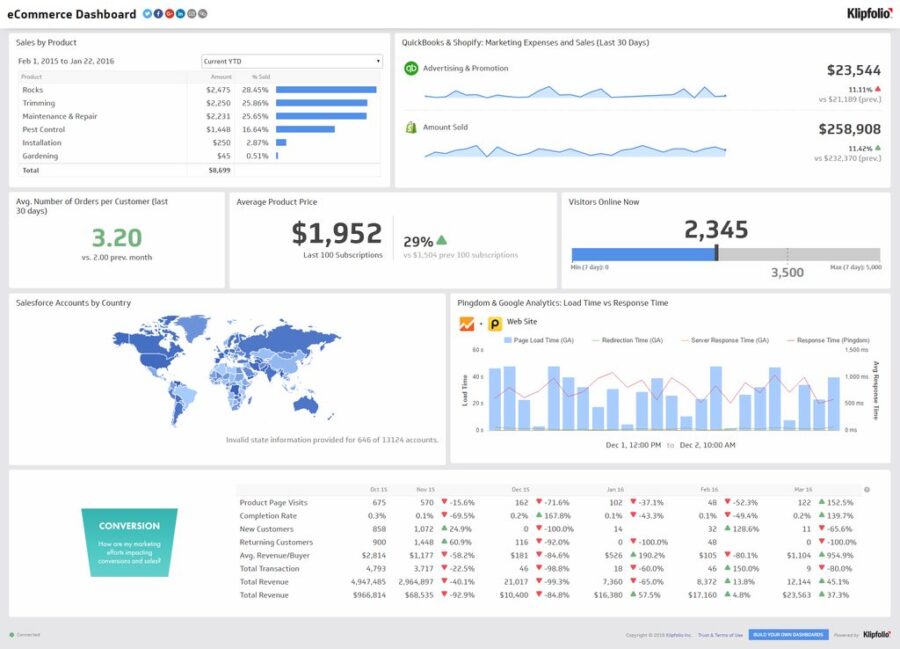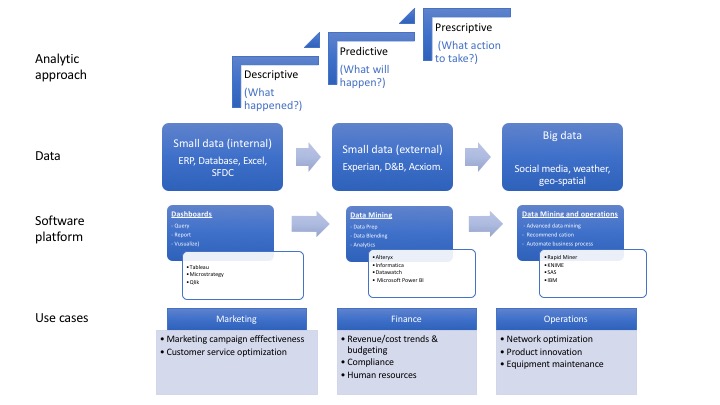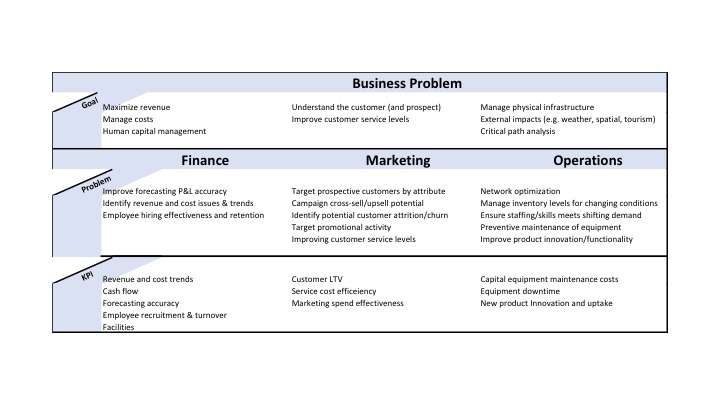Let’s start with the bottom line – there is no excuse for virtually any company today, regardless of size or manpower (and within reason), not to be making data analyics a part of their normal business routines. Traditional objections such as cost, resources and expertise no longer cut the mustard. As many observers have noted, a company’s internally generated data is a key asset that needs to be leveraged in the same way as any other corporate asset if the business is to survive and thrive in today’s increasingly competitive environment.
The 4 main questions that need to be resolved are:
- what are the short term and long term objectives?
- who should be responsible for the effort?
- what specific problems should be addressed?
- what tools should be used to support the initiative?
However, the perceived complexity of the field can be overwhelming. There are many buzz words being bandied around – analytics, big data, business intelligence, predictive analytics and on the list goes. If you are a small or medium sized business (SME) with limited resources you likely have enough on your plate just managing the business as it is without throwing new tools into the mix. Sure – the big guys have the bench strength and financial wherewithal to experiment and gain incremental advantage from these (relatively) new technologies but the small guy (and his team) know their industry inside out and the risk/reward does not stack up.
Wrong!
The marketplace in virtually every industry is becoming more global and more commoditized and change is accelerating. Differentiating your product or service on any level (price, quality, functionality, scale etc) is harder. The need to work smarter, not harder is critical to grow, if not to survive. In all likelihood, you are probably performing some level of analytics already using excel and other traditional tools. If members of your team are combining multiple spreadsheets and overlaying with salesforce data, as well as performing more v-lookups and pivot tables on a cyclical basis than is healthy, you are probably ready to get more organized in your approach to BI. The decision to formalize the analytics function should be seen as an extension of existing practices rather than a leap into some unknown terrain.
How does an SME do that?
Like any overwhelming issue, and at the risk of over-simplifying, it becomes a lot easier to address if it is broken down into smaller elements. The good news is that the barriers that used to exist – time, expertise and cost are no longer impediments. But, like anything worthwhile, a little planning, organizational structure, top down direction and bottom up enthusiasm will go a long way to generating results. The diagram below is designed to help simplify the data analytics universe.
By assessing each of these areas it becomes easier to formulate a plan that starts with some simpler, low hanging fruit and progresses to more complex analytics, data types and tools. Begin by focusing on a single functional area (say the marketing area) and crystalizing the answers to the question “what happened”, using internal data (e.g. from the accounting systems and salesforce) and using a software platform that provides great visualizations, then migrate to a self-service analytics platform (possible the same tool or one that integrates with the visualization platform) to address more complicated, forward-looking questions.
Who should be responsible?
As noted above, there should probably be an executive sponsor. Most likely this will be either the Chief Financial Officer or Chief Marketing Officer. These executives already live in the data world and should be attuned to problems that can be addressed by a more formal analytics effort. Such an executive will likely already have some sense of how analytics could help do his or her job better.
Of course, the process needs someone who will be rolling up their sleeves and doing the hard day to day work and will be the go-to person for all questions – the tech-savvy business person increasingly known as the Citizen Data Scientist. This person probably will self-select – a spreadsheet jockey with the right curiosity quotient who enjoys getting into the weeds. In fact, they may be ahead of management in recognizing how a more effective and formal data analysis process will help them and the company better succeed. And – if they’re smart, they will know that improving their skills in this area can only make them more marketable and valuable. Once again, this person is highly likely to already work in either finance or marketing which may facilitate the executive sponsor decision.
What are the objectives?
This is an important question to get right. At a high level, the objective is to develop a systematic process for making business decisions that are consistent, repeatable and yield better results. However, data analytics is a journey not a destination, so starting with a plan to build buy-in from the C-Suite (and the broader organization) will enable the data scientist to lay the foundations for developing the necessary data and analytical infrastructure. Again, it is a truism, but planning the effort to generate a few “quick wins” will likely aid in getting the broader team engaged and developing the desired culture. I suggest an approach along the following lines:
- Start with descriptive analytics by building fairly simple dashboards to highlight corporate performance focused on analyzing existing transactional data sources but telling management something they don’t already know (or at least were unsure of or could not prove)
- Progress to developing drill down capabilities into dashboards and sharing with relevant colleagues to provide deeper insights into performance issues and spreading the right culture more broadly throughout the organization
- Develop more sophisticated analyses that blend different data sources (internal and external) in order to better answer specific business questions and provide real-time insight into performance (e.g. what is the likelihood that a customer will defect?)
- Move on to more advanced predictive analyses and data sources (e.g. social media data) and incorporate analytic results into the business processes to ensure consistency of treatment.
Dashboards (Descriptive)
Dashboards are the starting point on the analytic journey. It is a truism that what is measured is managed and by developing a single source of truth, all executives will be working from the same playbook. Of course, what is relevant to one group may be meaningless to another – so some thought should be given to the purpose or theme of the dashboard, data to be included, the audience who will rely on the information and specific questions the dashboard is designed to answer. A good dashboard will help drive the decision-making process rather than simply present information. Many dashboard examples can be reviewed through a simple google search. I have set out a couple of marketing and finance dashboards (downloaded from google) that I believe are clear, visually appealing and informative examples.


A well designed dashboard can do more than simply portray what has happened. It can also direct the reader’s attention to what needs to happen and focus management attention on trends and potential problem areas (and successes) before they become more serious. More sophisticated dashboards can also provide drill-down capability to enable team members with sharing rights to develop a more dynamic and real-time view.
Data Blending, Exploration and Query (Predictive)
Once the dashboard process is bedded down, it is time for the data scientist to get more ambitious. A logical next step is to consider using more and different data to provide some different perspectives on the decision domain and to perform more advanced analysis. By blending company specific data from multiple sources and also enriching with third party data from sources such as marketing or other data vendors (e.g. Experian, Acxiom, D&B etc.) or social media feeds such as Facebook or Twitter, the analyst can explore the data for new and better insights that provide a more robust view of company performance.
At this point the SME and the Citizen Data Scientist are likely on the analytic journey and will be keen to explore new and different types of data and use more advanced analytics to solve new and interesting business problems. Today’s software tools have intuitive work flow environments with drag and drop user interfaces to manage data prep and uploading, control the analytic workflows and analytic model development. Many also integrate with visualization platforms to facilitate the presentation and sharing of reports within the organization.
Deploy analytics into business processes and scale (Prescriptive)
At this point, the smaller company has probably reached the peak of its needs and cost/benefit trade-off. Enterprise level companies with different needs in terms of data, customers, regulations and specific business problems/issues and with different budgets and internal skill-sets have vendors who address their more unique needs. They operate at a scale where the ability to operationalize the analytics into their business processes and workflows becomes more important and economic. Often these companies will be in regulated industries where they need to be able to demonstrate that they have fair and repeatable treatments in place.
What Problems Should be Solved?
Each company will have its own priorities and issues that should be addressed. However, the broad nature of questions that may be analyzed can be categorized according to the diagram below. Some good general rules of thumb would include:
- Only choose questions that matter
- Aim for practicality of solution rather than the perfect answer
- Keep the nature and knowledge of the audience in mind (and evangelize successes to this audience)
- Remember that what is measured is managed
What tools to use?
The market for data analysis tools has evolved considerably in recent years – much to the benefit of the Citizen Data Scientist. Self-service analytics tools are now fairly mainstream and have brought data analysis into the business user’s domain. However, this segment of the software market can be confusing as many vendors have moved from a specific tool towards developing broader and overlapping platforms than can manage many of the global tasks that are central to a self-service analytics environment such as data governance and sharing of insights within the organization.
The good news is that the cost of entry is low and vendors pack a lot of punch into their offerings. Many vendors offer free trials and free or low cost entry level versions which typically have restrictions on the volume or type of data that can be used. But, this may be enough to get started and gain the knowledge to make a more informed purchase decision at the right time. In fact, the Citizen Data Scientist may choose to test out several different tools to see what works best for their needs prior to pulling the trigger on a particular tool.
The diagram above sets out some key vendors under various categories. As also stated earlier, this is somewhat simplistic given the overlapping functionality of the various categories (descriptive, predictive, prescriptive) but it hopefully provides a framework by which analytics software companies can be considered. It is not the intention of this paper to do a side by side comparison or recommendation of various tools. Fortunately, there are many resources available to assist prospective users evaluate and compare competing BI solutions. That said, some knowledge of core common capabilities may be useful in evaluating vendors against a company’s specific needs and priorities.
- Number and scope of data connections
- Pre-built dashboards
- Drill down capability
- Publishing and sharing capability
- Integration with data blending and exploration software
- Ability to scale (volume and types of data)
- Number and accuracy of modeling approaches
- Customer reference base in specific industry
Summary
It is an exciting time to delve into the world of business intelligence and analytics. Companies are generating more data and the tools available to exploit that data are readily available, easy to use and cost effective. There are lots of resources that are easy to access – in fact, the software vendors themselves make the process fairly painless.
So, there is no excuse not to jump in. And – with a little planning and coordination, even smaller businesses can compete with the big boys when it comes to being smart in using data to make better decisions.


